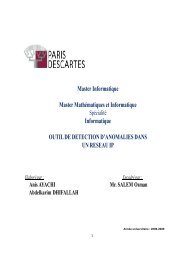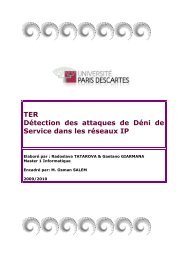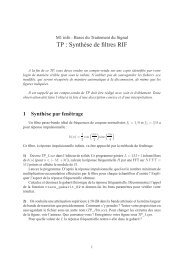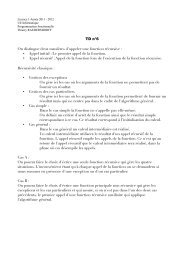Th`ese de Doctorat de l'université Paris VI Pierre et Marie Curie Mlle ...
Th`ese de Doctorat de l'université Paris VI Pierre et Marie Curie Mlle ...
Th`ese de Doctorat de l'université Paris VI Pierre et Marie Curie Mlle ...
Create successful ePaper yourself
Turn your PDF publications into a flip-book with our unique Google optimized e-Paper software.
A.2.3 Implementation of the Dynamic Bandwidth Allocation al-<br />
gorithms<br />
In this Section, we <strong>de</strong>scribe in some <strong>de</strong>tail the principal phases of our bandwidth allocation<br />
algorithms implementation.<br />
First, we created the n<strong>et</strong>work topology and we implemented the CST tables along with<br />
a s<strong>et</strong> of traffic monitors and traffic conditioners (token buck<strong>et</strong>s) at ingress routers.<br />
The basic role of traffic monitors is to perform online measurements on the incom-<br />
ing traffic flows. These measurements are then collected and exchanged b<strong>et</strong>ween ingress<br />
routers to update the CST tables, accordingly, with the state information regarding each<br />
connection.<br />
It should be clarified that the CST table, implemented at each ingress router, contains<br />
the state information concerning all connections offered to the n<strong>et</strong>work. In effect, each<br />
ingress router updates the CST table with the state information regarding connections<br />
that enter the n<strong>et</strong>work through it and then exchanges update messages with other ingress<br />
routers to maintain the state information regarding all the connections of the n<strong>et</strong>work.<br />
On the other hand, token buck<strong>et</strong>s are used to regulate each connection sending rate<br />
according to the allocated bandwidth computed by our bandwidth allocation algorithm.<br />
Each link in the n<strong>et</strong>work, along with the correspon<strong>de</strong>nt param<strong>et</strong>ers (the maximum<br />
capacity, the residual capacity, <strong>et</strong>c.) is implemented in the Java class OneLink.java. The<br />
s<strong>et</strong> of links are implemented in a table named LinksTable, where each element corresponds<br />
to one instance of the Java class OneLink.java.<br />
Every update interval (i.e. Tu seconds), the proposed bandwidth allocation algorithms<br />
proceed as follows:<br />
• CST tables implemented in ingress routers are updated with the current actual in-<br />
formation concerning all connections entering the n<strong>et</strong>work. This information <strong>de</strong>rives<br />
from the statistics gathered by ingress routers. Table A.2 shows how the CST table<br />
98










